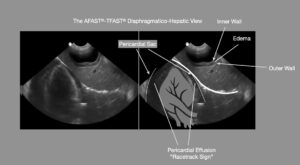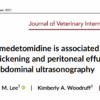Ultrasound Assessment of the Gallbladder Wall: An Important Marker in the Acute Setting
Stephanie Lisciandro, DVM, DACVIM (SAIM)
Ultrasound assessment of patients is extremely important in the acute veterinary setting. Point of care ultrasound (Global FAST®) should be used in addition to thorough physical exam and laboratory evaluations to offer the timeliest diagnosis and therapeutic intervention in critical patients. Ultrasound assessment of the gallbladder has proven to be an important tool. The finding of gallbladder wall edema (GBWE) in acutely ill patients can be a marker for anaphylaxis, right sided heart failure, pericardial effusion, or acute cholecystitis. Other documented causes include hypoproteinemia, immune-mediated anemia, sepsis, pancreatitis, and post-transfusion (likely immune-mediated; possibly volume overload).
In this discussion, we will focus on gallbladder wall edema in patients with cardiac disease. This was reviewed in a recent article in the Journal of Veterinary Internal Medicine entitled, “Thirteen dogs and a cat with ultrasonographically detected gallbladder wall edema associated with cardiac disease” (JVIM 2021; Lisciandro GR, et al). Knowing this significant ultrasound finding is especially important in the emergent setting since patients with anaphylaxis and cardiac disease may have similar presentations including acute weakness and collapse.
Gallbladder wall edema. Pericardial effusion can be seen as a anechoic rim around the heart at the AFAST®-TFAST® Diaphragmatico-Hepatic View on Global FAST® exam.
It in this study, gallbladder wall edema is described as an ultrasonographically striated gallbladder with mural thickening ranging from 3-5 mm. This finding is also commonly known as the gallbladder halo sign. Of the dogs, 11 of the 13 dogs had pericardial effusion, one had dilated cardiomyopathy and one had right ventricular myocardial failure. In addition, 9 of the 13 dogs had ascites. One cat was also included in study and this patient had right sided heart failure associated with a ventricular septal defect; the cat also had ascites.

In patients with acute weakness and/or collapse, ultrasonographic assessment of the gallbladder is very important. Patients with ascites are often presented for abdominal ultrasound and thoracic pathology is missed since these animals often do not have heart murmurs. It is important to remember to look past the diaphragm with enough depth to see into the thorax at the AFAST®-TFAST® Diaphragmatico-Hepatic View when evaluating the liver to look for pericardial effusion. It is also important to assess these animals for distention of the caudal vena cava and hepatic veins – see CVC blog.
In animal with a gallbladder halo sign secondary to anaphylaxis, the caudal vena cava is often small or collapsed due to decreased venous return. A distended vena cava with lack of bounce (due to the dynamic changes during cardiac and respiratory cycles), supports the presence of cardiogenic gallbladder wall edema. The point-of-care protocol for Global FAST® (AFAST®, TFAST®, and Vet BLUE® combined – the video) incorporates a standardized assessment of all of these findings to allow a more accurate diagnosis of pericardial effusion or right sided heart failure versus other causes of gallbladder wall edema.
Ultrasound assessment is a valuable tool for the assessment especially in the emergent setting, but I would advise ultrasound assessment in any sick animal as an extension of the physical exam. Please sign up for our emails or join the FASTVet.com for additional resources regarding using ultrasound every day in your practice.
References:
- Lisciandro GR, Gambino JM, Lisciandro SC. Thirteen dogs and a cat with ultrasonographically detected gallbladder wall edema associated with cardiac disease. J Vet Intern Med 2021;35: 1342–1346. https://doi.org/10.1111/jvim.16117.
- Chou Y, Ward JL, Baron LZ, Murphy SD, Topf MA, Lisciandro GR, et al. Focused ultrasound of the caudal vena cava in dogs with cavitary effusions or congestive heart failure: a prospective observational study. PLoS One 2021;16(5):e0252544. doi:10.1371/journal.pone.0252544.
- Lisciandro GR. Abdominal and thoracic focused assessment with sonography for trauma, triage and monitoring in small animals. J Vet Emerg Crit Care 2011;21(2):104-122.
- Lisciandro GR. The use of the diaphragmatico-hepatic (DH) views of the abdominal and thoracic focused assessment with sonography for triage (AFAST/TFAST) examinations for the detection of pericardial effusion in 24 dogs (2011-2012). J Vet Emerg Crit Care 2016; 26(1):125-31.
- Nelson NC, Drost WT, Lerche P, et al. Noninvasive estimation of central venous pressure in anesthetized dogs by measurement of hepatic venous blood flow velocity and abdominal venous diameter. Vet Radiol Ultrasound 2010;51(3):313-323.




